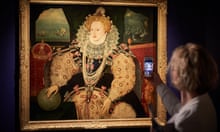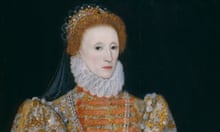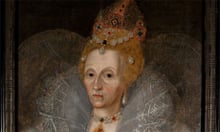1. Elizabeth I
Elizabeth is probably England’s greatest princess. She overcame odds that were decidedly stacked against her by the time she made it to the throne, and by the time she left it, her country was in a golden age. Elizabeth was a girl in the turbulent years following the death of Henry VIII, third in line to the crown but widely considered to be illegitimate. She survived the rule of her father, her brother, and her sister, none of whom wished her to succeed them, and took the throne at the age of 25. Elizabeth sought to end the religious strife that had torn her country apart. When it came time to marry, she could not do it, understanding that any marriage could be a threat to her position. Instead, she styled herself as the Virgin Queen, a queen married and dedicated to her people and country alone. Elizabeth’s reign is marked by a flourishing of the arts and voyages of discovery, and one can hardly picture her without an accompanying image of Shakespeare or Walter Raleigh. But throughout her rule, she was still faced with danger and uncertainty, with threats from the outside coming in forms such as the Spanish Armada or her cousin Mary, Queen of Scots. Elizabeth handled them all, from a magnificent appearance at Tilbury and the defeat of the Armada to the more fraught occasion of executing Mary. The image of Elizabeth’s rule is still one of triumph and glory. She is, after all, Gloriana.

2. Yennenga
Yennenga lived in the Dagomaba Kingdom of the early 12th century, which in modern day is northern Ghana. She was the daughter of King Nedega, and from the time she was young she was training to be a warrior. She was good at it. Yennenga was skilled with javelin, spear, and bow, and was a better horse rider than her brothers. She was beloved by everyone, and fearsomely skilled in battle, commanding her own battalion. Yennenga was so valued by her people and so needed by her father as a leader that when she came of age, he refused her to marry, going so far as to lock her up when she tried to convince him to let her go. But she wasn’t having it. In the night, she escaped with the help of one of Nedega’s guards, and headed north. A skirmish with the neighbouring Malinke warriors cost her helpful friend his life, and she continued alone until she came to the house of Riale, a famous elephant hunter, who fell in love with her on the spot. This is a warrior princess who got to live happily ever after, and today Yennenga is known as the mother of the Mossi people.
3. Pingyang
At the end of the Sui Dynasty, China was a hard place to live, especially if you were a peasant, and more especially if you were unfortunate enough to be working on one of Emperor Yang’s grand projects, like the Great Wall of China. Emperor Yang, knowing he was unpopular and paranoid about it, signalled for the execution of many of his generals, including Pingyang’s father Li Yuan. Li Yuan started a rebellion, and when Pingyang got word of it (she was living with her husband in the Capitol), she joined. Pingyang was a deft hand at raising an army, and she did it through winning hearts, not brutality. She sold her family’s possessions and gave money and food to the peasants, winning them over, and turning them against their oppressors, bringing those people into her fold as well. She commanded over 70 0000 soldiers by the end of it, and employed a strict no raping or pillaging policy, endearing her to the common people forever. They were called “the Army of the Lady.” Li Yuan eventually overthrew Emperor Yang, and founded the Tang Dynasty, a golden age for China. Princess Pingyang is often recognized as the only woman to have had an imperial military funeral in the country.
4. Boudicca
When Pixar was making Brave and casting the look for a feisty British princess, it’s not hard to imagine they took a look at Boudicca for inspiration. It’s that unmistakable pile of red hair. Boudicca was queen of the Icini tribe in Britain during the time of Emperor Nero. When her husband died, she had a right as per his will to half of the kingdom inherited by her daughters, while half was to go to occupying Roman forces. Instead, the Romans, under governor Gaius Suetonius Paulinus annexed the whole of her lands, making a brutal example of Boudicca and her daughters. Boudicca rebelled, gathering several of her neighbouring tribes together, all of whom had been mistreated by the occupying Romans. Boudicca’s uprising took several cities including modern Colchester, London, and St Albans. Faced at last with Suetonius himself, Boudicca’s army was a poor match for the professional Roman soldiers, and she was defeated, though the image of her calling to her troops from her chariot, to the last, is a powerful one that lives on.
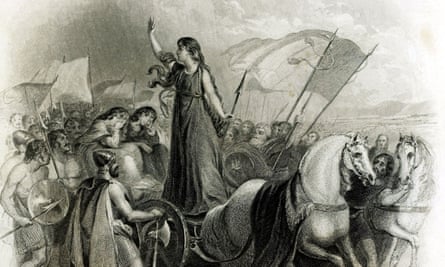
5. Olga of Kiev
Olga’s husband was Igor of Kiev, and she must have loved him very much. Or loved her position as Queen very much. Or had zero time for nonsense or treachery. Because when Igor was killed by the Drevlian tribe in 945, Olga showed no mercy. And she was perhaps a little too vengeful, depending on your tastes for vengeance. When the Drevlians sent a company to persuade Olga to marry their prince and give up her lands to them, she had them buried alive. When she invited 20 of their best men over to talk about the possibility, she had them locked in the bathhouse, and then burned the bathhouse. She then took her vengeance campaign on the road, besieging the town of Iskorosten, and after tricking them into thinking they were safe, burned that to the ground as well. And so Olga raised her son (who was three when his father died) to be the next ruler, but acted as regent until then. It wasn’t all fire and brimstone though, Olga recognised that the tribute system needed to be fixed as it was anger over this that led to Igor’s murder. She carried out the first recorded legal reform in Europe while changing it. Olga’s son Svyatoslav was often on military campaign, leaving her with a great amount of power even after he took the throne. Olga converted to Christianity, and, in spite of her rampaging, she is declared a saint in the church equal to the Apostles (one of only five women with this honour) for spreading the word about Christianity.
6. Rani Lakshmibai
Rani Lakshmibai is a hero of the Indian Rebellion of 1857. Wife of the Maharaja of Jhansi, Raja Gangadhar Rao Niwalkar, she was Queen of the Jhansi State in northern India. She gave birth to a son, who died very small, and the the Maharaja fell ill. They adopted a child before he died. After her husband’s death, the occupying British government refused to recognise her adopted son as heir, even though she processed her son’s adoption through all the proper legal channels and with witnesses. Rani Laksmibai was ordered by Governor General Dalhousie to evacuate her home and give up her title for a pension. Dalhousie wished to seize the state of Jhansi, Rani Lakshmibai was firm in wanting to protect her people and lands, and trouble was on the rise. In May 1857, mutiny in Meerut kicked off a rebellion against the British, the First War of Indian Independence. Initially reluctant to join as the rebellion spread, she was provoked when Sir Hugh Rose laid siege to Jhansi. The Rani had many faithful fighters in her army, including women she had trained, some of whom were in her personal guard. The siege was ferocious, and Lakshmibai and her people defended it with passion to the last, when, defeated, she escaped in the night with her son and guards. She then joined rebel forces elsewhere, and kept fighting, dying in battle. Rose called her the “most dangerous of all the rebel leaders,” and she became a symbol of resistance and heroism in India.
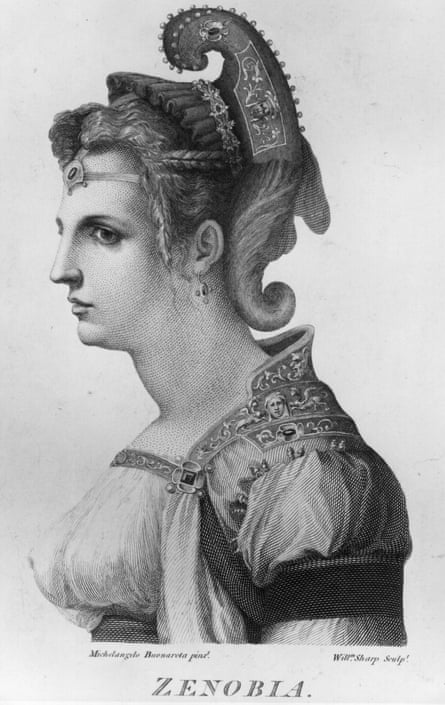
7. Zenobia
Zenobia was queen of the Palmyrene Empire, modern Syria, in the third century. She is described as beautiful and intelligent, and liked to carry herself “as a man,” enjoying hunting and riding - occasionally drinking as well. Her husband Odaenathus was ruler of Palmyra, under Rome. Odaenathus reclaimed the eastern provinces of his empire when they fell to the Persians, and earned himself the title King of Kings. When he was assassinated along with their eldest son, Zenobia took over as regent and also took to expanding the empire even further. She gave her baby son the title Augustus, and to herself she gave the title Augusta. Zenobia had a skilled army and soon she was not just protecting her land, but invading others. In 269, she conquered Egypt. She then took massive swaths of Anatolia, Syria, Palestine and Lebanon. She took important trade routes, and issues coins with her own face on them. At this time, the Roman Emperor Aurelian was campaigning in the Gallic Empire, but figured he should probably head east and deal with the warrior queen. They met near Antioch, and in defeat, Zenobia’s short lived empire was over. But as to her death, there are several versions, including some where she lives out a long life.
8. Lozen
An Apache warrior and prophetess, Lozen was the sister of the great chief Victorio, living in Arizona in the mid 19th century. Early on, Lozen enjoyed learning the skills of a warrior, and soon the art of war itself. She was never interested in the traditional roles for Apache women, and fought alongside her brother, who called her his right hand, and a shield to their people. Lozen was not only a fighter, but a well known medicine woman. She had an extensive knowledge of healing medicine, and was known to be able to divine crucial information about their enemies from her ceremonial rituals. Lozen also fought alongside of the famous Apache warrior Geronimo. She never married but was very close to another Apache woman named Dahteste, who was quite different from herself. Where Lozen didn’t care what she looked like, Dahteste was a noted beauty of great intelligence, fluent in different languages, who took a lot of pride in how she wore her hair and clothes, and carried herself with a regal bearing. Still Dahteste was as good a rider as Lozen, and the are so often mentioned together that they have obtained an iconic status in the Native American two-spirit community.
9. Basina and Clothild
Basina was the daughter of the Frankish king Chilperic I, and Chlothild was her cousin, daughter of Charibert I. When Basina’s family was killed by an epidemic of dysentery and her one remaining brother was assassinated, she was sent at the age of seven to live in an abbey, where her cousin Chlothild was living also, but not before being humiliated and stripped of her inheritance. The Abbey of the Holy Cross at Poitiers was not the nicest place, and the cousins seem to have chafed under the thumb of the abbess when they themselves were royal blood. But amazingly, in 589, Chlothild and Basina led a rebellion against the Abbess. Even more amazingly, they gathered an army - reputedly of thugs and criminals - to help them do it. Basina and Coltilda’s rebel nuns and their thugs abducted the Abbess (whose name was Leubovère) and ransacked the abbey, and took refuge in a nearby church. Eventually Leubovère escaped, but all of this activity outraged the bishop, as you might imagine. Basina sought peace at this point, but Chlothild was still ready for a fight. The ruckus they made caused the cousins to be excommunicated. Later, however, they were pardoned by King Childebert, who had once tried to quell them. Chronicler Gregory of Tours notes (possibly with a sigh,) “the scandal could not be settled.” Basina returned to a quiet monastery life, while Chlothild was granted lands where she ruled without further trouble.
10. Aud the Deep Minded
A list of mostly warrior princesses would not be complete without a viking. Aud the Deep Minded lived out a viking odyssey all her own. Aud was born in Norway and sailed as a child with her family to the Hebrides as her father Ketill Flatnose styled himself a King of the Isles there. Aud married Olaf the White, he was a viking King of Dublin, she a viking princess of the Isles. Together they had a son named Thorstein the Red, who tried to conquer Scotland. Eventually, all the fun of taking over places was bound to catch up with the family (for instance, Olaf liked to raid the tombs of Irish kings, this didn’t go over well), and indeed Olaf died a little mysteriously, though probably not pleasantly. There is no real record of his death. Thorstein was killed soon after, likely by a plot against him from disgruntled Scottish chiefs. At this point, with Aud’s father Ketill also dead, the family’s fortunes in the UK and Ireland were not looking good, so it was time to go. Aud would not live under the yolk of some other ruler, and so in her middle age she commissioned a ship to be built in secret in the woods, then she loaded it up with her family, friends, and slaves, and led an expedition to Iceland (marrying off her daughter along the way in Orkney), where she joined her brothers. Her prisoner slaves were given status as freed bondsmen when she landed. Aud is recognised as a key founder of Iceland, a lady of great influence and resilience.

Kate Beaton is the author of The Princess and the Pony. Princess Pinecone wants to be a great warrior. For her birthday, she asks for a great horse fit for a champion. What she gets is a small, round pony. Things don’t look good for the upcoming battle (a warrior’s favourite pastime) but Pinecone is set on achieving her dreams, and there might be something of a champion in the doughy little pony after all. Find out more about Kate Beaton and her books. Buy The Princess and Pony at the Guardian bookshop


